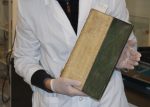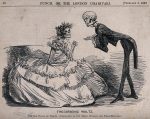Researchers at the University of Southern Denmark have discovered that three of the volumes in the university’s library rare books collection are poisonous. All three of them are history books. (Is it weird that that makes me inordinately proud?)
 The books were not suspected of having killed a number of monks in a forbidding monastery in the Italian Alps. In fact, the study had nothing to do with identifying lethal literature. These three books were selected because they were known from previous investigation to have medieval manuscript fragments in their covers. Recycling old parchment was a common practice for bookbinders in the 16th and 17th centuries. Researchers aimed to use imaging technology to identify which Latin texts had been used to make the covers, or at least to recover legible passages.
The books were not suspected of having killed a number of monks in a forbidding monastery in the Italian Alps. In fact, the study had nothing to do with identifying lethal literature. These three books were selected because they were known from previous investigation to have medieval manuscript fragments in their covers. Recycling old parchment was a common practice for bookbinders in the 16th and 17th centuries. Researchers aimed to use imaging technology to identify which Latin texts had been used to make the covers, or at least to recover legible passages.
The books were X-rayed, but the ink handwriting on the fragments was difficult to read through the thick layer of green paint on the outside of the covers. To break through the green barrier, the team tried using X-ray fluorescence analyses (micro-XRF) which is routinely used by painting conservators to analyze the chemical composition of pigments.
The idea was to filter through the layer of paint using micro-XRF and focus on the chemical elements of the ink below, for example on iron and calcium, in the hope of making the letters more readable for the university’s researchers.
But XRF-analysis revealed that the green pigment layer was arsenic. This chemical element is among the most toxic substances in the world and exposure may lead to various symptoms of poisoning, the development of cancer and even death. […]
The green arsenic-containing pigment found on the book covers is thought to be Paris green, copper(II) acetate triarsenite or copper(II) acetoarsenite Cu(C₂H₃O₂)₂·3Cu(AsO₂)₂. This is also known as “emerald green”, because of its eye-catching green shades, similar to those of the popular gemstone.
 Paris green is an intense, brilliant color that was resistant to fading. These qualities made it popular, especially in the 19th century when it was found in everything from oil paints to clothes dyes to artificial flowers and wreaths. When people realized their dresses were killing them in the second half of the 19th century, Paris green fell into disuse as an aesthetic option and went on to a new career as a pesticide and insecticide. Researchers believe it was for the latter purposes that the book covers were painted with Paris green likely in the 19th century.
Paris green is an intense, brilliant color that was resistant to fading. These qualities made it popular, especially in the 19th century when it was found in everything from oil paints to clothes dyes to artificial flowers and wreaths. When people realized their dresses were killing them in the second half of the 19th century, Paris green fell into disuse as an aesthetic option and went on to a new career as a pesticide and insecticide. Researchers believe it was for the latter purposes that the book covers were painted with Paris green likely in the 19th century.
It seems we aren’t likely to find out what medieval Latin manuscripts were diced up by the bookbinders any time soon.
Under certain circumstances, arsenic compounds, such as arsenates and arsenites, may be transformed by microorganisms into arsine (AsH₃) – a highly poisonous gas with a distinct smell of garlic. Grim stories of green Victorian wallpapers taking the lives of children in their bedrooms are known to be factual.
Now, the library stores our three poisonous volumes in separate cardboard boxes with safety labels in a ventilated cabinet. We also plan on digitising them to minimise physical handling. One wouldn’t expect a book to contain a poisonous substance. But it might.